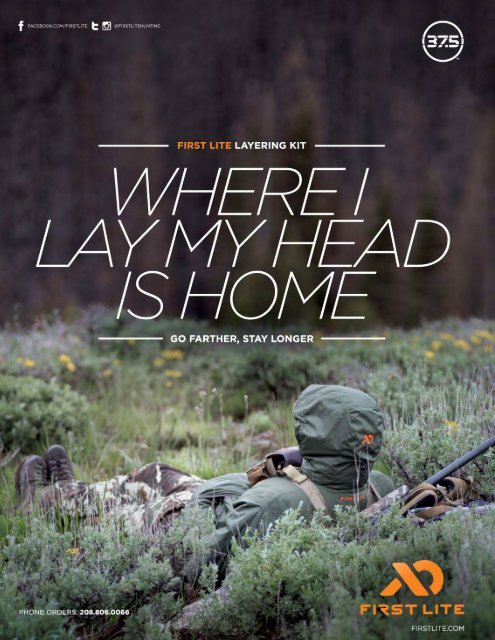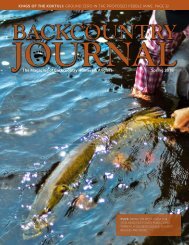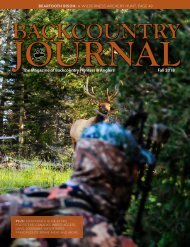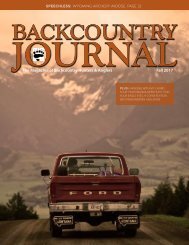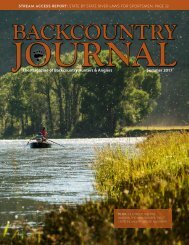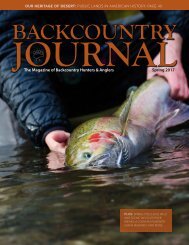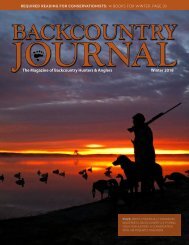BCJ_WINTER17 Digital Edition
You also want an ePaper? Increase the reach of your titles
YUMPU automatically turns print PDFs into web optimized ePapers that Google loves.
OPINION<br />
Sam Lungren photo<br />
WHITETAIL INDUSTRIAL COMPLEX<br />
BY BEN LONG<br />
AMERICA’S FOUNDING FATHERS HAD THIS FEAR of “the<br />
tyranny of the majority.” That is, if one larger group of people got<br />
too much power, it was bad for the whole democracy. That is why<br />
we have the Bill of Rights – to protect the rights of those who are<br />
outnumbered.<br />
Hunters should think of America’s public lands as a biological<br />
Bill of Rights. Those lands protect us from what I call the tyranny<br />
of the whitetail.<br />
First off, let me vow loyalty to King Whitetail. They are tasty,<br />
beautiful and fun to hunt. The bulk of my hunting time is spent<br />
pursuing whitetails, and they make up most of my protein intake.<br />
According to surveys by the National Shooting Sports Foundation,<br />
some 10 million American hunters pursue whitetail deer<br />
annually. By comparison, all other big game species account for<br />
only 300,000 hunters annually – a mere 3 percent. As a result,<br />
whitetail deer cast a mighty big shadow. They dominate the license<br />
fees (and thus agency priorities), the biological research, the<br />
trophy books, the outdoors media and the hearts and minds of<br />
American hunters.<br />
If whitetail deer did not exist, wildlife managers would probably<br />
genetically engineer a similar creature to thrive in modern<br />
America of industrial agriculture and urban sprawl. Whitetails<br />
need very little space – even a big buck can live its life contentedly<br />
on a single square mile. They breed rapidly to make up for<br />
heavy predation, whether it be by cougar, coyote, automobile or<br />
riflemen. They happily fatten on crops like soybeans or alfalfa.<br />
The ultimate generalists, they thrive in the deserts of Arizona, the<br />
frigid north woods of Canada, the swamps of Florida and city<br />
parks nationwide. If all wildlife were as flexible, we would need<br />
no Endangered Species Act.<br />
Whitetails are an all-American game animal. But they are not<br />
the only one. North America is blessed with more than 20 big<br />
game species, none of them as ubiquitous, but each as special.<br />
Look at it this way: Nothing against Bud Light, America’s most<br />
popular beer, but isn’t America richer for all our myriad of brews?<br />
Not all wildlife is as flexible as whitetail deer, living their lives<br />
in one square mile. Whitetails “fit between the cracks” of civilization,<br />
but many other popular big game species cannot. For<br />
example, some mule deer in Wyoming migrate 150 miles between<br />
summer and winter ranges. Pronghorn populations in Montana<br />
and southern Canada migrate 200 miles. A typical bull elk in the<br />
Rocky Mountains may use a home range of 15 square miles. A<br />
single grizzly bear requires 50 square miles. Bighorn sheep and<br />
mountain goats are habitat obligates – meaning they require a<br />
certain kind of rugged escape cover to survive.<br />
Big game needs big country. Whitetail deer are the exception<br />
that proves the rule.<br />
So where do these non-whitetail big game species live? In short,<br />
they live on public lands – the great national forests, grasslands,<br />
parks, and Bureau of Land Management acres of the American<br />
West (along with adjoining private timber and ranch lands). That<br />
public estate amounts to 640 million acres shared by people and<br />
wildlife alike. Because of the foresight of sportsmen and other<br />
conservationists over the past 100 years, this estate provides the<br />
foundation for North America’s wildlife heritage, even as the human<br />
population surpasses 310 million.<br />
Back in the 1990s, biologist Jack Ward Thomas noted that 80<br />
percent of America’s elk depend on public lands for at least part<br />
of their life cycle. The percentage is probably close to 100 percent<br />
for mountain goat, bighorn sheep, moose and other big game.<br />
In short, our national forests give wildlife the kind of space they<br />
need to thrive, even if they are not whitetail deer.<br />
“Public lands offer the broad expanses necessary for biodiversity<br />
and ecosystem function. You cannot parse up the land into<br />
smaller and smaller pieces and expect it to maintain the fabric<br />
of nature,” said biologist and wildlife advocate Shane Mahoney.<br />
“Having a nation anywhere in the world with millions of acres<br />
available to the citizens is an extraordinary gift and legacy.”<br />
Alarmingly, there are voices today who would liquidate that<br />
legacy. These people have the same anti-public lands philosophy<br />
that Theodore Roosevelt faced when he started to cobble together<br />
America’s network of public lands.<br />
I would also argue that public lands offer a certain authenticity<br />
of the hunt that is eroding rapidly in whitetail country. With the<br />
private-land, intensive wildlife management and food-plot practices<br />
of today, whitetail hunting is increasingly focused on manipulating<br />
the habitat and herds to produce shooting opportunities.<br />
While management can (and should) improve habitat on public<br />
lands, big game on public lands remain primarily as they have<br />
existed for the ages. On public lands, you shape your hunting to<br />
the ecosystem instead of shaping the ecosystem to the hunt.<br />
Thanks to TR and those like him, America’s wildlife heritage is<br />
whitetail deer plus much, much more. If we want to keep it that<br />
way, we’ll need to keep our public lands in public hands.<br />
Idaho outdoor writer Ron Spomer put it this way: “Public lands<br />
personify this idea we call America – which is freedom. The human<br />
animal – the human spirit – is not intended to be confined<br />
to a cage.”<br />
Ben is the vice chairman of BHA’s national board of directors. He<br />
ate whitetail for dinner last night.<br />
22 | BACKCOUNTRY JOURNAL FALL 2016 WINTER 2017 BACKCOUNTRY JOURNAL | 23


